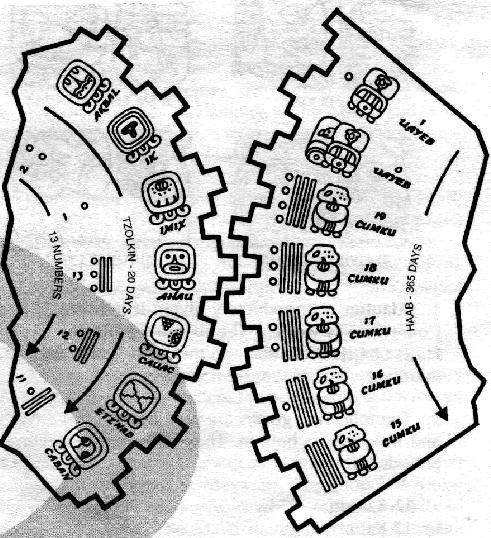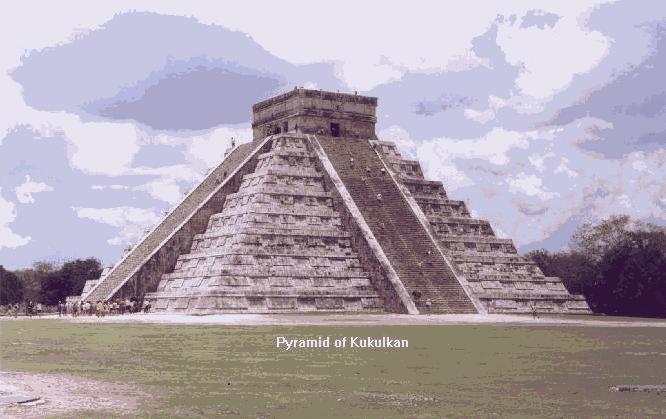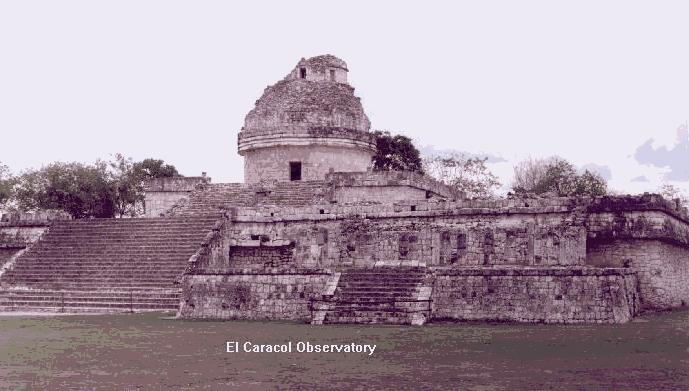The Mayan Calendar(s)
Jack Kramer
Of all the cultures in the first millenium, the Maya of Mexico's Yucatan Peninsula had developed what was arguably the most precise calendar of the time. This stems from the fact that they were accomplished astronomers. It's generally agreed that they reached their zenith roughly between 800 and 1100 AD, after which they were supplanted by the Aztecs as the dominant culture in what is now Mexico. When the Spaniards reached this part of the New World, they found descendants of the Maya still living in the region, but they had long since abandoned their great cities. In a way, this helped make it possible for us to learn quite a bit about the Maya. The Spaniards had a habit of destroying native cultures and artifacts in the name of Christendom, but they ignored the deserted Mayan citadels...or simply never found many of them in the dense jungle.
For all their architectural feats, astronomy, alphabet, mathematics, and screen-fold books made of amate paper, the Maya were essentially a Stone Age people. They had gold, but because there is a lack of other metallic ores in the region, they did not use bronze or iron. Instead, implements such as knives were generally made of obsidian. But intellectually, they were far beyond many Iron Age people. The Mayan mathematics used a dot (-) to represent the quantity 1 and a bar (—) to represent 5. They also used zero as a mathematical quantity to represent complementation, rather than nothingness. Zero was represented by a sea shell or clenched fist symbol. It's not surprising that with their penchant for abstract thought, they should develop a refined astronomy.
The Maya actually employed four different calendars, each serving a different purpose. The Long Count reckoned time from the beginning of the Mayan era, which they considered to have begun on what would be August 13, 3113 BC by our calendar. The Tzolkin was the sacred calendar with a 260-day cycle. The derivation of this calendar is uncertain, but one speculation is that it's based on the synodic period of Mars, which comprises three cycles of 260 days each. Another notion is that the visibility of Venus as the morning and evening star is nearly 260 days. This latter explanation may be the more plausible because the planet Venus held special importance for the Maya. The Haab is the civil calendar of 365 days, composed of 18 months of 20 days each, plus 5 supplementary days at the end of the year. It was called the "vague" year, because it was 6 hours shorter than the solar year. Finally, there is a Lunar Series or Supplementary calendar, which was used to track the moon's age, duration of cycle, number of the lunar day, and other data not yet deduced by archeologists. To the Maya, the moon was the main female deity.
Having multiple calendars seems confusing to us, but the Maya viewed the Tzolkin and Haab calendars as running concurrently, much as a large and small gear mesh together and run in synchronization. The following illustration shows how they saw the two calendars meshing.

The Maya carved important dates onto obelisks, with the characters reading left to right and top to bottom. The Aztecs who came after them inscribed their dates on stone or clay disks.
The hub of the Mayan world was the city of Chichen-Itza. The most impressive structure there is the Pyramid of Kukulkan, which is built over another pyramid. Unlike the Egyptian pyramids, this one is a gigantic civil calendar. On each of the four sides, there are 91 steps, which along with the platform at the top, represents 365 days. On each side, there are 52 panels representing the 52-year cycle of the Mayan calendar. (In my photo below, note the people on the steps of the pyramid. For purposes of preservation, 1999 is the last year that visitors will be allowed to walk up the pyramid.)

The observatory ("El Caracol") is another major structure. As an amateur astronomer, I was especially interested in seeing this. Like most present day observatories, the top of the structure has a circular chamber. This one has eight windows through which the Mayan astronomers would make their precise observations of the four cardinal directions and the solstices and equinoxes.

For all their sophistication, the Mayan culture had what we would regard as a serious flaw. The ritual practice of human sacrifice was rampant. Three sites at Chichen-Itza were devoted to these macabre events. The natural well (cenote) was where sacrificial victims, mostly women and children, were thrown. A yearly ball game was played in the ball court, and the captain of the winning team was beheaded. His head was then displayed in the adjacent Temple of the Skulls. In the Temple of Chac Mool, victims (generally warriors) had their hearts torn out. The Maya viewed it as an honor to be sent into the afterlife as an emissary of their people. Though they excelled in astronomy and architecture, apparently they never held life as something to be cherished.
Published in the October 1999 issue of the NightTimes




